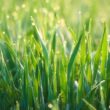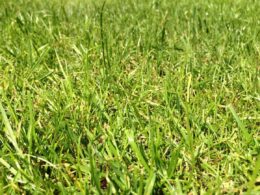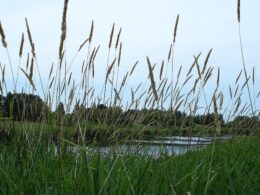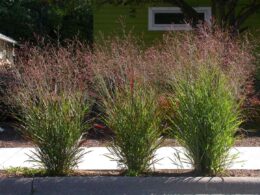What Is St Augustine Grass?
St. Augustine grass (Stenotaphrum secundatum) is a popular choice for lawns in warm climates. It is a warm-season grass that grows best in temperatures between 80 and 95 degrees Fahrenheit. It’s a medium to high-maintenance grass that produces a dense sod (like a carpet) and tends to crowd out most weeds and other grasses. Because of its dense growth habit and ability to withstand heavy foot traffic, St. Augustine sod is often used on golf courses, sports fields, and in other high-traffic areas.
St. Augustine Grass Appearance
St. Augustine grass is recognized by its broad, flat leaves that have a light green to blue-green color. The leaves are arranged in a V-shaped pattern. The grass has a thick, dense growth habit, which helps it crowd out weeds and resist insect damage. St. Augustine grass is a warm-season grass, meaning it goes dormant during the winter months. In cold weather, the grass will turn brown and stop growing. However, it will green up again in the spring as the weather warms.
St. Augustine Grass Types
There are several types of St. Augustine grass, each with its own unique features. One popular variety is ‘Floratam,’ which is known for its dark green color and resistance to disease. ‘Palmetto’ is another popular variety, which is distinguished by its fine texture and dense growth. ‘Sapphire’ is a newer variety of St. Augustine grass that is characterized by its deep blue-green color. Regardless of the type, all St. Augustine grasses share a common trait: they are all warm-season grasses that are well-suited for growing in hot, humid climates.
St. Augustine Lawn Care
St. Augustine grass is a warm-season turfgrass that is common in the southern United States. It is a medium to high maintenance grass that requires regular watering, mowing, and fertilizing. If you live in an area with hot summers, it is also important to provide shade and/or irrigation to prevent the grass from going dormant. St. Augustine grass can be susceptible to diseases, so it is important to choose a variety that is resistant to the diseases that are common in your area. With proper care, St. Augustine grass can be a beautiful and durable lawn.
Propagating St. Augustine Grass
St. Augustine grass is a popular type of turfgrass that is used in many yards and gardens. This grass has a deep green color and a dense, coarse texture. It is also relatively tolerant to salt and shade, which makes it a good choice for areas that are challenging to grow other types of grass. St. Augustine grass can be propagated by using stem cuttings or by layering. For stem cuttings, choose a healthy section of grass that is at least six inches long. Cut the section at an angle, just below a leaf node. Place the cutting in moist sand or soil, and keep it out of direct sunlight until new growth appears.
Layering
Layering is another easy way to Propagate St. Augustine grass. Simply bend a low-growing branch of the grass so that it touches the ground. Cover the area where the branch is touching the ground with moist sand or soil, and keep it watered until new roots have formed, and the branch can be cut from the parent plant. With either method, you will have success Propagating St. Augustine Grass as long as you choose healthy plant material and provide adequate moisture.
How to Mow St. Augustine Grass
The first step is to choose the right mower blade. A sharp blade is essential for preventing damage to the grass blades and achieving a clean cut. Second, set the mower deck at the correct height. For St. Augustine grass, a setting of 3 inches is ideal. Finally, be sure to mow in a pattern that evenly distributes the clippings. Leaving too many clippings on the lawn can lead to thatch buildup, which can damage the grass. By following these simple tips, you can keep your St. Augustine grass looking healthy and beautiful all season long.
Controlling the Weeds
For any lawn to look its best, it’s important to control the growth of weeds. Unfortunately, this can be a challenge, particularly with St. Augustine grass. This type of grass is highly susceptible to infestation by weeds, which can quickly take over the lawn if left unchecked.
The good news is that there are a number of effective weed control products on the market. By using these products regularly, it’s possible to keep your St. Augustine grass healthy and free of weeds. In addition, regular mowing and watering will also help to keep weeds at bay. With a little effort, it’s possible to enjoy a beautiful, weed-free lawn all season long.
Common Problem With St. Augustine Grass
One common problem with St. Augustine grass is brown patches. These brown patches can be caused by a number of factors, including drought, lack of fertility, insects, and disease. Improper mowing can also cause brown patches, as can compaction of the soil. Another common problem with St. Augustine grass is that it is susceptible to chinch bugs. Chinch bugs are small insects that feed on the grass, causing it to turn yellow and then brown. Left unchecked, chinch bugs can kill a lawn very quickly. If chinch bugs are present, they can be controlled with insecticides.
Disadvantages of St. Augustine Grass
Although St. Augustine grass is a popular choice for many homeowners, it does have some disadvantages. For one thing, it is a high maintenance grass that requires regular mowing, watering, and fertilizing. It is also susceptible to disease and pests, which can be difficult to control. In addition, St. Augustine grass is not tolerant of cold weather and can be damaged by frost. As a result, it is not a good choice for areas with cool winters. Homeowners who are not willing to put in the extra work and expense may want to choose another type of grass for their lawns.



















